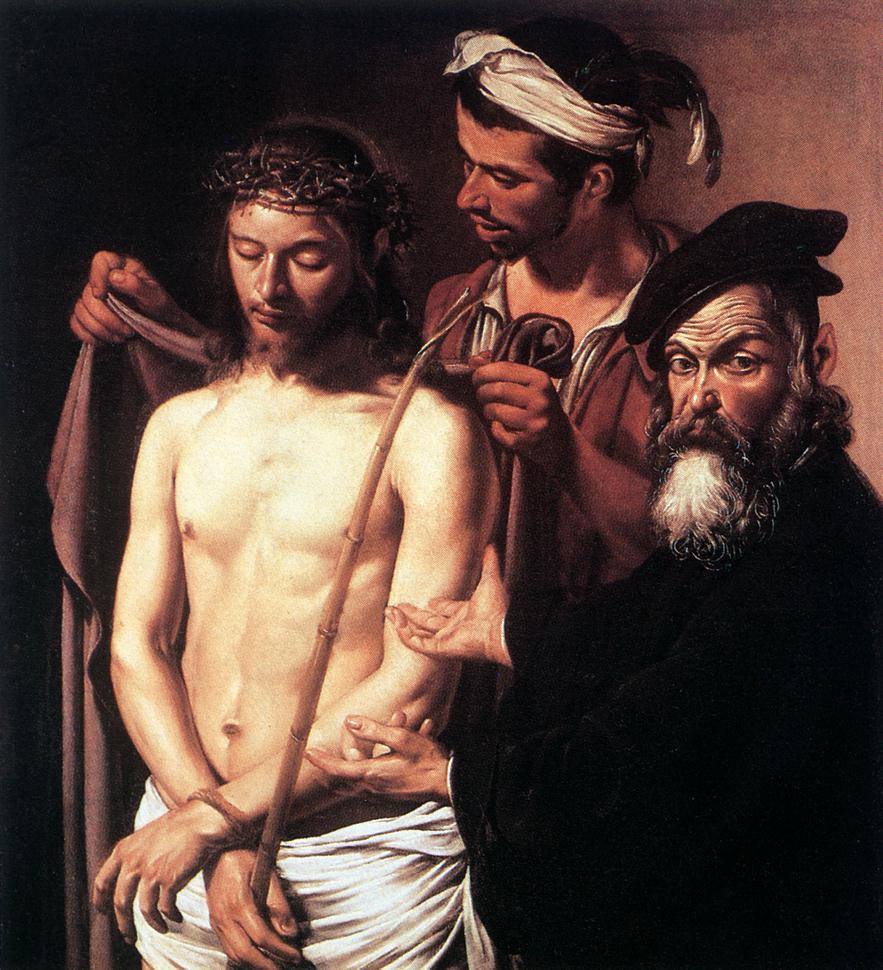- Ecce Homo (Caravaggio)
title=Ecce Homo
artist=Caravaggio
year=c. 1605
type=Oil on canvas
height=128
width=103
museum=Palazzo Rosso, Genoa"Ecce Homo" (c. 1605/6 or 1609 according to John Gash - see references below) is a painting by the Italian master Michelangelo Merisi da
Caravaggio (1571-1610). It is housed in thePalazzo Rosso ,Genoa .According to Giambatista Cardi, the nephew of the Florentine artist
Cigoli , CardinalMassimo Massimi commissioned paintings on the theme of Ecce Homo from three artists, Cigoli, Caravaggio, andDomenico Passignano , without informing any of them of the commissions to the other two. According to Cardi the cardinal liked his uncle's version best. The scene is from theGospel of John (John 19):Pontius Pilate displaysChrist to the crowd with the words, "Ecce homo!" ("Behold the man" - the man the crowd wishes to crucify). Caravaggio has combined Pilate's displaying of Christ with the slightly earlier moment when Christ, already crowned with thorns, is mockingly robed like a king by his tormentors. Massimi already possessed a "Crowning with Thorns" ("The Crowning with Thorns I") by Caravaggio and this was presumably intended as a companion piece.Stylistically the painting displays all the signs of Caravaggio's mature Roman-period style - the forms seen close-up and modelled by dramatic light, the absence of depth or background, and the psychological realism of, especially, the torturer, who seems to mix sadism with pity. Pilate, in keeping with tradition, is shown as a rather neutral figure, almost a sympathetic one.
The contract for "Ecce Homo" was signed on 25 June 1605, with the painting to be delivered by August. Whether Caravaggio was in a position to meet his deadline is uncertain, as by July he was in jail, not the first time, for attacking the house of two women, Laura della Vecchia and her daughter Isabella. Friends stood bail for him, but on 29 July he was in far more serious trouble, this time for assaulting the notary Mariano Pasqualone over a well-known courtesan named Lena, Caravaggio's model and referred to by Pasqualone in his police complaint as "Michelangelo's (i.e. Caravaggio's) girl". Caravaggio fled to Genoa, and did not return to
Rome until the end of August. During the rest of the year he continued to be in trouble with the law, with a complaint against him in September for throwing stones at his landlady's house, and a mysterious incident in October in which he was wounded in the throat and ear (Caravaggio claimed he had fallen on his own sword). In May 1606 he fled Rome again after killing Ranuccio Tomassoni, and was not settled inNaples until the latter part of that year.Cigoli's "Ecce Homo" was not painted until 1607, and clearly attempts to mimic Caravaggio's style, suggesting that Massimi had not yet received his Caravaggio and was turning elsewhere. [ [http://www.wga.hu/index1.html wga.hu] ] It is instructive to compare the two paintings: Caravaggio, unlike Cigoli, has dropped the convention of showing Christ's torturer as a grotesque, and has shown Pilate dressed as a 17th century official.
References
*cite book|first=John |last=Gash|title=Caravaggio|year=2003|id=ISBN 1-904449-22-0
*cite book|first=Helen |last=Langdon|title=Caravaggio: A Life|year=1998|id=ISBN 0-374-11894-9
Wikimedia Foundation. 2010.

